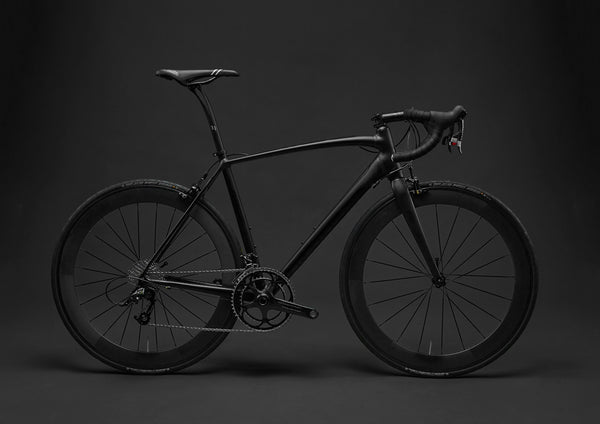Since bicycles have been around for well over 100 years, there have been many different types of bicycles brakes. This is not supposed to be an exhaustive study of the history of bicycle brakes. Rather, we want to offer you a guide of what you will most commonly find when shopping for a new bike.
When searching for the perfect bike for your style of riding, deciding on the right braking method will be the key to narrowing your search. Overwhelmingly modern bikes come equipped either with disc brakes or rim brakes. And though rim brakes were for many decades the norm for road bikes, within the past several years disc brakes have supplanted rim brakes not only for mountain and touring bikes, but road bikes as well.
What are rim brakes?
As the most basic definition, a rim brake stops the bike by squeezing two opposing brake pads against the rim of the bike wheel. Rim brakes have been in use since the 1890s with the advent of pneumatic tires. And up until the past several years, they remained the most popular option particularly for road bikes.
With such a deep history, there have been many different rim brake designs, though the side pull, developed by Campagnolo in the 1960s because the most popular design that use used well into the 1990s. These single-pivot brakes use two curved arms crossing at one pivot point with one side attached to the cable that pulls the arms together when the brake lever is squeezed. It’s a lightweight and easy to maintain design, but will be hard to find on new modern bikes.

If you are looking to buy a new rim brake bike, then you will most likely be finding bikes designed with direct mount rim brakes. Direct mount rim brakes attach onto the frame using two integrated mounting points. These dual pivot points enhance the braking power of the system and can allow for wider tires than single pivot rim brake.
Rim brake pros & cons
Though rim brakes still have committed proponents, they are slowly being phased out both by frame and component manufacturers. Nevertheless, you can still find certain high end bikes that offer a rim brake option as well as disc brake. Pinarello notably still offers rim brakes for their marquee model. That’s because rim brakes are lightweight and easier to maintain than disc brakes. And when ridden in dry conditions, rim brakes offer a high level of braking and much better modulation than disc brakes. However, in wet conditions, especially when used in conjunction with carbon rims, braking strength suffers.

What are disc brakes?
When listing what are the different types of bicycle brakes, disc brakes undoubtedly have taken the lead in popularity for road, gravel, and mountain bike design. A disc brake essentially uses a metal rotor attached to the wheel’s hub that rotates with the wheel. A caliper mounted to the frame and fork uses specially designed pads that slow the bike through friction when pressed to the rotor when the brake lever is pulled.
Though disc brakes initially worked mechanically via a cable connected to the brake levers, hydraulic disc brakes have become much more common especially on higher-end road, gravel and mountain bikes, like those you will find for sale on Wrench Science. Instead of a cable pulling at the caliper, hydraulic disc brakes use a piston in the brake lever to push hydraulic fluid through the brake hose to the caliper, forcing the brake pads to contract and put pressure on the rotor.

What are disc brake pros & cons?
As with almost everything when dealing with cycling equipment, there are definite benefits to disc brakes that require certain trade-offs. Disc brakes offer definite and noticeably better braking than rim brakes, especially when using carbon rims. And that becomes all the more apparent in wet conditions. The consistency of the braking capability remains the same even in very wet and muddy conditions.
Disc brakes have been used for longer on mountain bikes thanks to the superior stopping power and also because the added weight disc brakes have made less of a difference in mountain biking. But the weight of disc brakes has always been an issue for road bikes and to a lesser extent gravel bikes. Luckily technology continues to improve and disc brake designs have been resulting in lighter and even more aerodynamic systems.
The slightly more involved level of maintenance with disc brakes, especially hydraulic disc brakes which require periodic bleeding of the brake fluid, is also one of the drawback self-mechanics highlights. But considering the overall exceptional performance and safety enhancement disc brakes bring to road, gravel and mountain bikes, having to bleed them every 12 to 18 months seems a small price to pay.

Which types of brakes for bicycles should you choose?
When deciding on which bike you want to purchase, the question of types of brakes for bicycles should be answered quite early in the search. Are you a weight weenie, looking to get yout climbing bike down to the absolute lightest weight possible? Or perhaps you are a committed self-mechanic and do not want to have to deal with the hassle of the added maintenance that disc brakes occasionally require. Then you should certainly give rim brake bikes a very close look. And we’d suggest you do it soon before all rim brake bikes are phased out – not something we see absolutely happening, but we do occasionally wake up at night in a cold sweat at the thought.
The ubiquity of disc brakes on all types of bikes – road, gravel, mountain bikes, even triathlon and time trial bikes – indicates just how useful and effective disc brakes are for all these types of bikes. The exceptional braking in all weather conditions, improved aerodynamic designs, and irrelevant weight gain thanks to lighter frames make disc brakes a great choice for any cyclist.
Though there are several other types of bicycle brakes such as cantilever, drum, V-brakes, U-brakes and even “spoon” brakes to name a few, if you are looking to purchase a new bike from Wrench Science, you won’t have to worry about all these retro and disused designs.
Please feel free to get in touch with us directly if you have any further questions about rim vs. disc brakes.




































































































































































































































































